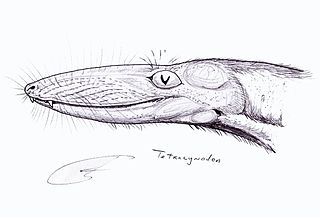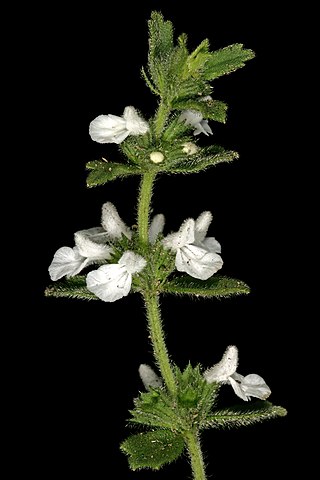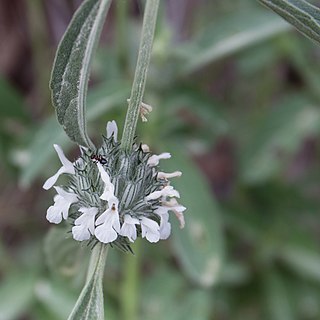Parelaphostrongylus tenuis is a neurotropic nematode parasite common to white-tailed deer, Odocoileus virginianus, which causes damage to the central nervous system. Moose, elk, caribou, mule deer, and others are also susceptible to the parasite, but are aberrant hosts and are infected in neurological instead of meningeal tissue. The frequency of infection in these species increases dramatically when their ranges overlap high densities of white-tailed deer.
In linguistics, a tenuis consonant is an obstruent that is voiceless, unaspirated and unglottalized.

Nepenthes tenuis is a tropical pitcher plant endemic to the Indonesian island of Sumatra. The species was first collected in 1957, from a remote mountain in the western part of the island. It remained undescribed until 1994, and was only rediscovered in the wild in 2002. Prior to this, N. tenuis was known solely from a single photograph and dried herbarium specimen.

The slender catshark is a small species of catshark belonging to the family Scyliorhinidae. It is found on the upper continental slope off the coast of Suriname, French Guiana and northern Brazil, including the mouth of the Amazon River at depths between 72 and 450 metres. Its it can grow up to a length of 70 centimetres (28 in).

The least pipistrelle is a species of vesper bat.

The Timor shrew or thin shrew is a species of mammal in the family Soricidae. It is endemic to Timor.

The thin mouse shrew is a species of mammal in the family Soricidae found in South Africa and possibly Mozambique.

Tetracynodon is an extinct genus of therocephalian. Fossils of Tetracynodon have been found in the Karoo Basin of South Africa. Two species are known: the type species T. tenuis from the Late Permian and the species T. darti from the Early Triassic. Both species were small-bodied and probably fed on insects and small vertebrates. Although Tetracynodon is more closely related to mammals than to reptiles, its braincase is very primitive and more resembles that of modern amphibians and reptiles than of mammals.
The voiceless or more precisely tenuis bilabial click is a click consonant found in some languages of southern Africa. The symbol in the International Phonetic Alphabet for a tenuis bilabial click with a velar rear articulation is ⟨k͡ʘ⟩ or ⟨k͜ʘ⟩, commonly abbreviated to ⟨kʘ⟩, ⟨ᵏʘ⟩ or just ⟨ʘ⟩. For a click with a uvular rear articulation, the equivalents are ⟨q͡ʘ, q͜ʘ, qʘ, 𐞥ʘ⟩. Sometimes the accompanying letter comes after the click letter, e.g. ⟨ʘk⟩ or ⟨ʘᵏ⟩; this may be a simple orthographic choice, or it may imply a difference in the relative timing of the releases.
The voiceless or more precisely tenuis dental click is a click consonant found primarily among the languages of southern Africa. The symbol in the International Phonetic Alphabet that represents this sound is ⟨ǀ⟩. The symbol in the International Phonetic Alphabet for a tenuis dental click with a velar rear articulation is ⟨k͡ǀ⟩ or ⟨k͜ǀ⟩, commonly abbreviated to ⟨kǀ⟩, ⟨ᵏǀ⟩ or simply ⟨ǀ⟩; a symbol abandoned by the IPA but still preferred by some linguists is ⟨k͡ʇ⟩ or ⟨k͜ʇ⟩, abbreviated ⟨kʇ⟩, ⟨ᵏʇ⟩ or just ⟨ʇ⟩. For a click with a uvular rear articulation, the equivalents are ⟨q͡ǀ, q͜ǀ, qǀ, 𐞥ǀ⟩ and ⟨q͡ʇ, q͜ʇ, qʇ, 𐞥ʇ⟩. Sometimes the accompanying letter comes after the click letter, e.g. ⟨ǀk⟩ or ⟨ǀᵏ⟩; this may be a simple orthographic choice, or it may imply a difference in the relative timing of the releases.
The voiceless or more precisely tenuis (post)alveolar click is a click consonant found primarily among the languages of southern Africa. The symbol in the International Phonetic Alphabet for a tenuis alveolar click with a velar rear articulation is ⟨k͡ǃ⟩ or ⟨k͜ǃ⟩, commonly abbreviated to ⟨kǃ⟩, ⟨ᵏǃ⟩ or simply ⟨ǃ⟩; a symbol abandoned by the IPA but still preferred by some linguists is ⟨k͡ʗ⟩ or ⟨k͜ʗ⟩, abbreviated ⟨kʗ⟩, ⟨ᵏʗ⟩ or just ⟨ʗ⟩. For a click with a uvular rear articulation, the equivalents are ⟨q͡ǃ, q͜ǃ, qǃ, 𐞥ǃ⟩ and ⟨q͡ʗ, q͜ʗ, qʗ, 𐞥ʗ⟩. Sometimes the accompanying letter comes after the click letter, e.g. ⟨ǃk⟩ or ⟨ǃᵏ⟩; this may be a simple orthographic choice, or it may imply a difference in the relative timing of the releases.
The voiceless or more precisely tenuis lateral click is a click consonant found primarily among the languages of southern Africa. The symbol in the International Phonetic Alphabet for a tenuis lateral click with a velar rear articulation is ⟨k͡ǁ⟩ or ⟨k͜ǁ⟩, commonly abbreviated to ⟨kǁ⟩, ⟨ᵏǁ⟩ or just ⟨ǁ⟩; a symbol abandoned by the IPA but still preferred by some linguists is ⟨k͡ʖ⟩ or ⟨k͜ʖ⟩, abbreviated ⟨kʖ⟩, ⟨ᵏʖ⟩ or just ⟨ʖ⟩. For a click with a uvular rear articulation, the equivalents are ⟨q͡ǁ, q͜ǁ, qǁ, 𐞥ǁ⟩ and ⟨q͡ʖ, q͜ʖ, qʖ, 𐞥ʖ⟩. Sometimes the accompanying letter comes after the click letter, e.g. ⟨ǁk⟩ or ⟨ǁᵏ⟩; this may be a simple orthographic choice, or it may imply a difference in the relative timing of the releases.
The voiceless or more precisely tenuis palatal click is a click consonant found primarily among the languages of southern Africa. The symbol in the International Phonetic Alphabet for a tenuis palatal click with a velar rear articulation is ⟨k͡ǂ⟩ or ⟨k͜ǂ⟩, commonly abbreviated to ⟨kǂ⟩, ⟨ᵏǂ⟩ or simply ⟨ǂ⟩. Linguists who prefer the old IPA letters use the analogous Beach convention of ⟨k͡𝼋⟩ or ⟨k͜𝼋⟩, abbreviated ⟨k𝼋⟩, ⟨ᵏ𝼋⟩ or just ⟨𝼋⟩. For a click with a uvular rear articulation, the equivalents are ⟨q͡ǂ, q͜ǂ, qǂ, 𐞥ǂ⟩ and ⟨q͡𝼋, q͜𝼋, q𝼋, 𐞥𝼋⟩. Sometimes the accompanying letter comes after the click letter, e.g. ⟨ǂk⟩ or ⟨ǂᵏ⟩; this may be a simple orthographic choice, or may imply a difference in the relative timing of the releases.
The voiceless or more precisely tenuis retroflex click is a rare click consonant. In practical orthography, an ad hoc symbol ⟨‼⟩ is used for the retroflex clicks; a tenuis click with a velar rear articulation is ⟨k͡‼⟩ or ⟨k͜‼⟩, commonly abbreviated to ⟨k‼⟩, ⟨ᵏ‼⟩ or just ⟨‼⟩. The implicit symbol in the International Phonetic Alphabet is ⟨k͡𝼊⟩ or ⟨k͜𝼊⟩, abbreviated ⟨k𝼊⟩, ⟨ᵏ𝼊⟩ or just ⟨𝼊⟩. Linguists who prefer the old IPA letters use the analogous Doke convention of ⟨k͡ψ⟩ or ⟨k͜ψ⟩, abbreviated ⟨kψ⟩, ⟨ᵏψ⟩ or ⟨ψ⟩. For a click with a uvular rear articulation, the equivalents are ⟨q͡‼, q͜‼, q‼, 𐞥‼⟩, ⟨q͡𝼊, q͜𝼊, q𝼊, 𐞥𝼊⟩ and ⟨q͡ψ, q͜ψ, qψ, 𐞥ψ⟩. Sometimes the accompanying letter comes after the click letter, e.g. ⟨𝼊k⟩ or ⟨𝼊ᵏ⟩; this may be a simple orthographic choice, or it may imply a difference in the relative timing of the releases.

Rupes Tenuis is a Martian north polar scarp. It is named after one of the classical albedo features on Mars. Its name was officially approved by IAU in 1988. It extends from latitude 74.94°N to 82.2°N and from longitude 242.12°E to 300.77°E. Its centre is located at latitude 81.6°N longitude 85.47°W. It marks the outer perimeter of Planum Boreum from longitude 242.12°E to 300.77°E, and it is formed by the eastern extension of the Olympia Cavi, a series of local troughs and depressions, which become longer and deeper as they merge to create the Rupes Tenuis scarp formation. The scarp is located to the west of Chasma Boreale, at the base of Planum Boreum, and its height varies from a few hundred metres to a maximum of approximately 1000 metres.

Aspledon Undae is one of the named northern circumpolar dune fields in the vicinity of Planum Boreum, the Martian North pole. It is named after one of the classical albedo features on Mars. Its name was officially approved by the International Astronomical Union (IAU) on 20 March 2007. Its name is Greek, and derives from the name of a town in Boeotia, Ancient Greece, which, in turn, took its name from Aspledon, son of Poseidon, the ancient Greek god of the sea. The dunes of Aspledon Undae extend from latitude 71.47°N to 75.14°N and from longitude 305.83°E to 315.04°E. Its centre is located at latitude 73.06°N, longitude 309.65°E (50.35°W), and has a diameter of 215.2 km.

Acrotome fleckii is a species of flowering plant in the family Lamiaceae. It is native to Namibia.

Acrotome hispida is a species of flowering plant in the family Lamiaceae. This species is native to South Africa. Acrotome hispida was first published in 1848.

Acrotome inflata is a species of flowering plant in the family Lamiaceae. This species is native to Africa. Acrotome inflata was first described in 1848 by George Bentham. The name "horsefright" is derived from the Afrikaans "perdeskrikbossie".
Acrotome pallescens is a species of flowering plant in the family Lamiaceae. It is native to Namibia and the Cape Provinces of South Africa. The name was first published in 1848.










